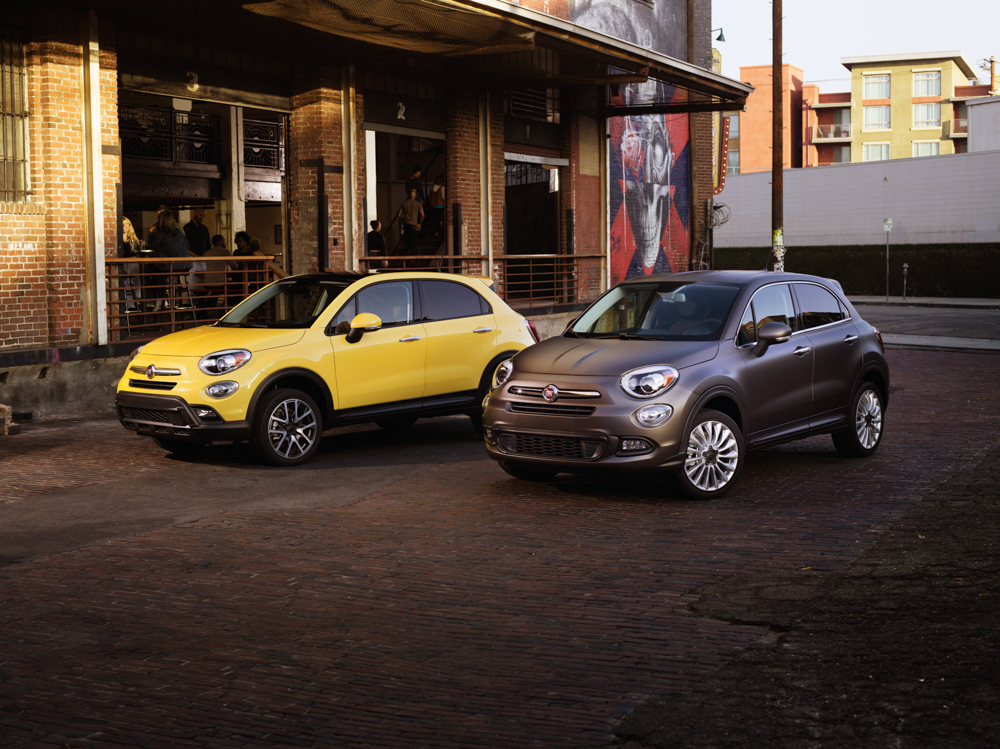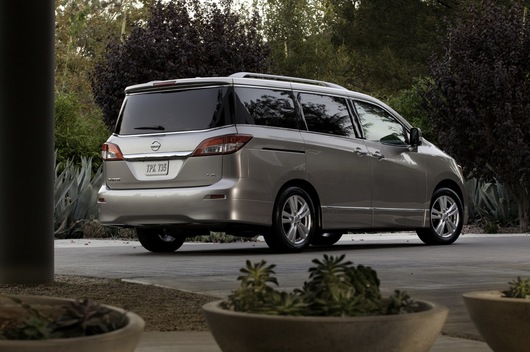Four legs good, two legs bad! was the cry of the rebellious animals in Orwell’s other classic, Animal Farm.
This applies to cars as much as politics.
Two “legs” (doors) are generally bad when it comes to trying to make a buck. They don’t sell in quantity because most people need more in the way of practicality.
Even Porsche has had to deal with this reality by adding the four-door Cayenne and Panamera to the mix.
Fiat’s feeling the same heat.
As perky and fun as the 500 micro-car may be, it’s a hard sell because it’s just too small – and has two few doors.
The Italians rushed the 500 L to the front lines last year to address the problem.
It had four doors – and more room – but something was still lacking. It hasn’t sold especially well – notwithstanding that other smallish (and FWD-only) box cars like the Kia Soul and Scion xB have sold well.
What was missing?
Maybe it’s more engine – and the option of AWD?
Enter the 500 X.
It has both.
Or at least, they’re available. Plus a higher-rent interior, more electronic features and more cuteness than a barrel full of dimples.
Maybe it’s the Fix that “Tony” has been looking for!
WHAT IT IS
The 500X is Fiat’s new subcompact crossover SUV.
It’s related to the Jeep Renegade – Jeep being owned by Chrysler (and Chrysler now owned by Fiat) and shares engines (and transmissions) but doesn’t have the Jeep’s off-road capability. It’s meant to be more of an urban hipster than a backwoods trail blazer.
Base price is $20,000 for the Pop trim with FWD, turbocharged 1.4 liter engine and a six-speed manual transmission.
The priciest X is the Trekking Plus, which comes with AWD, a larger 2.4 liter engine and the option to buy a dual-pane glass roof, a Beats premium audio system and electronic safety features such as lane departure warning and forward collision warning.
This one stickers for $27,100.
Major rivals of the 500 X include the Honda HR-V ($19,115 to start) Mazda CX-3 ($19,960 to start) and the Chevy Trax ($20,120 to start).
If you can manage with a tight second row, you might also want to cross-shop the Mini Countryman – especially the S ALL4 (AWD-equipped) version. It stickers for $27,870 – within a few hundred bucks of the price of a 500 X Trekking Plus.
WHAT’S NEW FOR 2016
The 500 X is a new model.
WHAT’S GOOD
A Fiat for those who need four doors – and want all-wheel-drive.
Available with either of two engines – main rivals come with just one – and the 500 X’s optional 2.4 liter engine is – by far – the strongest one (180 hp) you can get in the $22k-$25k-ish price range (with the exception of the 500 X’s Fiat-badged – and skinned – brother, the Jeep Renegade).
About 10 cubic feet more cargo capacity than the roughly same-sized 500 L.
Excellent gas mileage (25 city/34 highway) with the standard 1.4 liter engine.
Optional (and higher-powered) 2.4 liter engine designed to drink regular unleaded.
Available with a manual transmission (Mazda CX-3 and Chevy Trax are automatic-only).
WHAT’S NOT SO GOOD
Manual only offered with the 1.4 liter engine – which is only available in the base/FWD version of this vehicle.
Optional 180 hp engine is thirsty – especially when paired with weight-adding AWD.
Base 1.4 engine designed to drink premium unleaded.
Nine-speed automatic (mandatory with the 2.4 liter engine) isn’t the smoothest box on the road.
Costs more than rivals when ordered with AWD.
Less total cargo space than most rivals.
The 500 X comes standard with the same “Multi-Air” 1.4 liter turbocharged four that’s used in the 500 L – but (unlike the 500 L) you can upgrade the X to a larger “Tigershark” 2.4 liter engine, if you want more power.
The 1.4 liter engine is pretty powerful, though.
Relative to what you get in rivals, anyhow.
It makes 160 hp pushing 22 pounds of turbo boost. That’s heap strong compared with the Honda HR-V’s 1.8 liter, 138 hp engine, the Mazda CX-3’s 2.0 liter, 146 hp engine – and absolutely blows the poor little Chevy Trax’s 1.4 liter, 138 hp engine right out of the water.
None of these models offer a more powerful optional engine, either.
The Fiat does.
Other-than-Pop trims come with a larger 2.4 liter four (no turbo) that makes 180 hp – a number matched only by the Mini Country S All-4 (which starts at $27,850 vs. $22,300 for a 500 X Easy with FWD; $24,200 with AWD).
You can also get a manual (six-speed) transmission in the Fiat – a rare feature in the class and new crossovers, generally.
Unfortunately, Fiat only offers the manual gearbox with the base 1.4 engine – and that engine is only available in the base Pop trim, and only with front-wheel-drive. If you want the larger engine – or all-wheel-drive – you have to accept the nine-speed automatic transmission, which has some issues (more on this below).
Acceleration is good for this class of vehicle: 0-60 takes about 8.8 seconds with the 2.4 liter engine and FWD. That’s right there with the HR-V and CX-3 (and much speedier than the under-engined Chevy Trax, which needs 10-plus seconds to break 60).
However, the Fiat’s gas mileage is lower than rivals when the car is equipped with the optional 2.4 liter engine.
Best-case is 22 city, 31 highway (21 city, 30 highway with AWD) which is about 5-8 MPG below what rivals like the HR-V (28 city, 35 highway with FWD; 27 city/32 highway with FWD) and CX-3 (29 city, 35 highway; 27 city/32 highway with AWD) deliver.
The 1.4 engine’s mileage is good – 25 city, 34 highway – however this engine requires premium unleaded fuel. Remember that bit about 22 pounds of turbo boost?
The X’s rivals – including the Chevy Trax, which is turbo’d, too – all take regular. As they probably ought to, given these are budget-minded buggies.
The nine-speed automatic has sport/manual modes and there are three driver-selectable settings (Normal, Rain/Snow and Sport) for the optional AWD system. It’s an on-road/street-driving-intended set-up, like the available AWD systems in rivals like the HR-V, Trax and CX-3.
The Fiat does have more ground clearance than its rivals: 7.9 inches with all-wheel-drive (about an inch less with FWD) vs. 6.1 inches for the CX-3, 6.7 inches for the Honda HR-V and 6.2 inches for the Chevy Trax. This should help get you through on snow days – but if you’re looking for more in the way of off-pavement capability, you might want to take a look at the 500X’s corporate cousin, the Jeep Renegade. It’s the only subcompact crossover currently available with Low range gearing as well as off-road terrain settings (sand/gravel/mud, etc.)
Though it’s still tiny relative to the average car (for perspective, a compact sedan like the Toyota Corolla is more than a foot longer overall) the X feels less small than the 500 hatchback – especially on the highway – probably because of the additional 109.6 inches of wheelbase (101.2 vs. 90.6 for the 500 hatchback) and several hundred pounds more curb weight (3,278 lbs. for the AWD model vs. 2,865 lbs. for the 500 hatchback).
The 500 hatchback is highway-capable but it’s not at its best dealing with the slipstream of Kenworths at 75 MPH. The 500 X is much better suited for such duty while still being small enough to be a fantastic “city car,” too. Indeed, it is slightly better as a city car than its rivals – by dint of being slightly smaller than all of them except the Trax (which is exactly the same overall length, 167.2 inches). The Honda HR-V, for instance, is a couple inches longer overall (169.1 inches) so it’s just that much less able to slot into and out of tight curbside parking spaces downtown. It also has a wider turning circle – 37.4 feet vs. 36.3 for the Fiat.
The Mazda beats ’em both, though – with the tightest turning circle in the class (34.8 feet).
Both of the Fiat’s engines have good power – and deliver class-competitive acceleration. The standard 1.4 engine’s 184 ft.-lbs. of torque is especially noteworthy because it provides the low-RPM scoot that’s absent in rivals – or rather, which you have to work their engines harder to access. The Fiat’s torque output is not only greater, it arrives much sooner – at just 2,500 RPM. The HR-V’s peak of 127 ft.-lbs., in comparison, doesn’t happen until the engine spins to 4,300 RPM.
Only the Chevy Trax comes close – with 148 ft.-lbs. available at just 1,850 RPM.
Like the Fiat, the Chevy’s turbocharged – and the turbo boost is what accounts for the handsome torque numbers. However, the Chevy manages those numbers on regular gas – while the Fiat must have premium to deliver them. That’s odd, given the 1.4 engine is the “economy” engine in the lineup.
Meanwhile, the optional 2.4 liter engine – the “performance” engine – is set up to operate best on regular.
Go figure.
The optional nine-speed automatic (which is effectively the standard transmission in all trims except the base FWD Pop) has four overdrive ratios. Sixth (0.81), seventh (0.70), eighth (0.58) and ninth 0.48) are there to cut revs – and thus, save gas.
In actuality, the nine-speeded Fiat’s numbers are not as good as rivals’ numbers, despite those rivals having transmissions with only six gears. Or no gears at all – if they have a CVT.
Part of the reason for this, of course, is that the 500 X has more engine and that necessarily entails a bigger appetite. It’s also heavier than its rivals, two of which (the Trax and the CX-3) weigh just over 2,800 lbs. or about the same as the much smaller 500 hatchback.
And the 500X would surely be even thirstier if it didn’t have those four overdrive gears.
But the downside of all those gears is a fairly busy transmission that’s been programmed to seek out those higher gears (to eke out the MPGs). That means lots of transitions – and sometimes, they feel harsh, probably because of the distance (ratio-wise) between say 4th or fifth and eighth or ninth. A six speed automatic might downshift two gears under moderate pedal.
The Fiat’s box might need to drop down four or more.
It’s hard to make that feel smooth – and often, it doesn’t feel smooth.
Other manufacturers (Honda) have gone with continuously variable (CVT) automatics to maximize mileage while maintaining smooth (and quiet) operating characteristics.
Unfortunately, government fuel-efficiency mandates rather than buyer/market demand are driving such extreme solutions as nine (and perhaps soon ten) speed automatics with multiple overdrive gears on top.
Absent government strong-arming, Fiat might have been able to offer the hunky 2.4 liter engine with the six-speed manual transmission. It would have made the thing much more fun to drive – and less busy to drive – if slightly less economical to drive.
The MPG difference likely would have been about 3-4 MPG less overall. You probably could live with that.
But the government can’t.
Which is why you can’t get the manual.
Like the Mini Countryman, the 500 X is a cheerful little thing. Even the seatbelt buzzer has a happy sound.
The interior features body-colored trim plates, available ambient mood lighting and you can order up various “Lounge Collection” option packages to individualize your ride.
The Trekking trim sounds rugged, but don’t be fooled. A Jeep in Fiat drag, it’s not. You’ll get a different front clip, fog lights and an 18-inch wheel/tire package – but no skid plates or Low range gearing. Head to your Jeep store for those things.
You can, however, get in-car WiFi, a heated steering wheel and 2D/3D GPS mapping.
The X is about the same size on the outside as the 500 L but the allocation of space inside is significantly different.
On the plus side, the X has about 10 cubic feet more cargo capacity than the L (32.1 cubic feet with the second row folded vs. 21.3 cubic feet) and the X’s rear cargo area also has additional versatility in the form of a secondary storage compartment hidden under the main trunk floor.
On the downside, the X’s second row legroom (34.8 inches) is a bit less than the L’s (35.2 inches) and a lot less than the HR-V’s (39.3 inches).
The Honda also kills when it comes to cargo capacity – both behind the second row (23.2 cubic feet) and with the second row folded down (59 cubic feet, best in the class).
The Mazda CX-3 also has about the same backseat legroom (35 inches) and significantly more total cargo capacity (44.5 cubic feet).
The often-insulted Chevy Trax (don’t ask me; I like the thing) does well on both counts, with 35.7 inches of second row legroom and a very impressive 48.4 cubic feet of total cargo capacity (nearly as much as the Honda HR-V).
Curiously – because the X is wider on the outside than the L – there is much less shoulder room in both of the X’s two rows: 54.3 up front and 52.8 in the back vs. 57.3 up front and 54.7 in the back for the L. The Honda HR-V also has more shoulder room in both rows as well.
Both the Mazda CX-3 and the Chevy Trax each have less.
A further curiosity is that headroom is tighter in the X (39 inches up front and and 37.8 in the second row) than it is in the L (40.7 inches up front and 39.3 in the second row). This is curious because the X is marketed as a crossover SUV – and crossover SUVs are usually designed to give you more rather than less headroom.
But then, these micro-SUVs are as much about form as they are about function.
This could redound to Fiat’s benefit – because the 500 X has much more stage presence than the nondescript-looking HR-V (and the even more vanilla-looking Chevy Trax). The 500 X’s biggest worry on this count is without doubt the Mazda CX-3.
It’s Lara Croft, Tomb Raider in her short shorts.
Fiat is a relative newcomer (a returncomer, actually) to the U.S. market and maybe should have priced this model more aggressively.
The base Pop trim is right there with the base trimmed versions of rivals like the HR-V, CX-3 and Chevy Trax, but when you add AWD to the mix ($24,200 for the least expensive version) you’re looking at spending more than you would for the AWD-equipped versions of the Honda ($23,125) and a lot more than you would for the least expensive AWD-equipped versions of the Mazda ($21,210) and the Chevy ($21,620).
Meanwhile – and similarly – you could buy a Mini Countryman S All-4 (AWD) with a turbo’d 181 hp engine paired with a manual transmission (remember, not offered in the Fiat) for $27,850 – a virtual dead heat with the $27,100 MSRP of a 500 X Trekking Plus with that less-than-fabulous automatic.
On the other hand, the 500 X has more engine than its comparably priced rivals – and its styling/personality/power are Mini Countryman comparable while being (generally) less expensive.
The AWD equipped (and 2.4 liter powered) Easy trim, for instance, stickers for about $3,650 less than the Countryman S All-4.
THE BOTTOM LINE
Maybe Fiat has finally found the sweet spot?
If you value independent media, please support independent media. We depend on you to keep the wheels turning!
Our donate button is here.
If you prefer to avoid PayPal, our mailing address is:
EPautos
721 Hummingbird Lane SE
Copper Hill, VA 24079
PS: EPautos stickers are free to those who sign up for a $5 or more monthly recurring donation to support EPautos, or for a one-time donation of $10 or more. (Please be sure to tell us you want a sticker – and also, provide an address, so we know where to mail the thing!)

















I’m not entirely sure what the appeal of this is supposed to be over the Jeep Renegade. Perhaps it has slightly better fuel economy (I haven’t done a direct comparison), but it still seems to lose out on capability, at least if you have the slightest interest in off-road chops, and after all, that’s why people buy crossovers instead of wagons, especially micro-utes like these, right?
Neither vehicle is particularly well styled and neither compare well to their main competition except that the Renegade at least has some degree of off-road capability that nothing else in this category can touch, though that doesn’t say much. I’d imagine the Jeep, with its slightly boxier design, may even have more interior volume.
In terms of reliability, I try and keep up with initial quality surveys as well as long-term reliability reports by make. Jeep and Fiat tend to be the bottom two in almost every report for the most recent few years. That doesn’t bode well for a model designed to do dual duty as a Fiat and a Jeep product.
As someone else here mentioned, history seems to repeat itself. I find it ironic that it was Fiat that was the most proximate cause of GM’s bankruptcy and bailout. A couple of years before the bailouts of GM, Chrysler, and Ford (the latter of which wasn’t called a bailout but was, for all intents and purposes, only a slightly smaller version of the same), GM and Fiat were in bed together to co-develop products. They managed to develop a few transmissions and engines together, some of which have made it into production (including the diesel in the Chevy Cruise that is also used by Fiat in Europe), but the marriage soured as GM’s products continually underperformed in the market and GM couldn’t hold up its end of the GM-Fiat deal. Thus they had to “buy out” the contract, according to the penalties, and Fiat made off like a bandit with massive GM money. This massive loss of capital, along with other really bad management, triggered the bankruptcy. Chrysler and Ford were failing at the same time, though the former was in far worse shape. So what happens? Fiat, flush with GM’s cash, turns around and buys Chrysler a couple of years later for a song AFTER the US taxpayer is forced to bail them out.
Had they all been permitted to be subject to market forces, GM and Chrysler would have been bought out by presumably more capable managers and be enabled to dump their inefficiencies, their horrible union contracts, etc. and come out stronger than ever. Ford may have limped along a little longer before failing, but we’d almost certainly have the big three in much better fighting shape than they are now. As it is, Ford is limping along, Chrysler is surviving off of gimmicks (Hellcat, nice gimmick, tho), and GM’s best mass-market products seem to be barely at industry average in competitiveness.
Anyone else have the sense that the auto industry is in a state of malaise? Lots of me-too products. Lots of boring. Nobody doing really good work. It feels like the 1980s all over again. Aside from a few baubles (e.g., Hellcat, Z06, GT500), nothing seems like it will be desirable as a true classic some 20-30 years from now.
Which is my contemplation for the day: What currently production vehicles do you think will be “classics” or “collectables” in the year 2040? That’s only 25 years from now. That’s like us looking back at 1990 now. Aside from the really high end stuff like Ferraris, Lamborghinis, and a smattering of 911s (and maybe a Cayman or two), what do you think we’ll look back on fondly and want to buy at Barrett-Jackson? That is, of course, assuming gasoline is still legal.
A four door version of the two door market laggard. Color me unimpressed.
Every automobile company that has sheltered the Jeep brand has lost a fortune or gone belly up. American Bantam, Willys, Kaiser, AMC, Chrysler, Mercedes and now Fiat. Can’t blame Jeep though, but that is quite a track record.
History = rinse and repeat.
This 500x is such a “cute” little thing. Eye pleasing inside and out. And as you said it exudes a feeling of fun, and style.
Sadly, many of us would never…ever…buy it. I’d be reluctant to even rent one. That old Fiat unreliability is harder to rid from the corporate culture than cancer. And the hookup with Chrysler fails to inspire confidence.
Too bad Toyota can’t collaborate with Fiat, like they did on the little sports car with Subaru.
A cute hatch with Fiat style, underpinned by ultra reliable Toyota mechanicals, would be hard to resist.
But this probably should be filed in the category of “things that are never going to happen.”
I have to agree, Mike… unfortunately.
Several people I took for rides commented about the rough shifts of the nine-speed automatic (I have noticed this – and written about it – in other FC cars, too). That box is not up to snuff. Even if it proves to be reliable, it is not pleasant and often feels (and sounds) as though it’s going to puke parts all over the road….
I very much doubt it will be reliable, after all FIAT has not earned the nickname of “Fix It Again Tony” for no reason. This time though, unlike relatively simple old-school 3 and 4 speed automatics it is likely the cost of repair will exceed the value of the vehicle when the time comes.
Heck, a sufficiently motived shade-tree mechanic can rebuild a 3-speed Torqueflite or similar tranny. Usually the hard parts are OK and all you need do is replace bands and clutches. I doubt that will be the case with this 9-speed monstrosity.
Everybody is rolling out another little shit box every couple years now. No parts interchangeability across any car lines which is a really bad thing in my view. I guess junkyards do a pretty good business since nobody seems to be able to drive anymore but getting a part from one vehicle to a different brand is gone like the wind. There’s a lot to be said for that too although I’m preaching to the choir here I realize.
It’s not just vehicles either. Nobody has a moral compass, no faith to one thing. I see the disposable pet business as another failure of Caesar’s design’s impending collapse into……..simply more numbers.